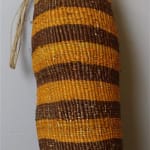Dimensional's 2019: 3D artwork from the Short St collection
Past exhibition
Dhimbura Bidingal
Bol’pu
pandanus (pandanus spiralis)
48 cm
833678
Further images
The age old practice of weaving baskets from the leaves of Pandanus continues today. Making these things is very labour intensive. Gathering the materials can be quite exhausting. The spiky...
The age old practice of weaving baskets from the leaves of Pandanus continues today. Making these things is very labour intensive. Gathering the materials can be quite exhausting. The spiky pandanus leaves are sometimes difficult to harvest, followed by the careful task of flaying the leaves before hanging them to dry. Only the few central leaves of the palm growing from the core which have not bent are used. These can be ten or twenty feet high so a special crook known as a Galpunaniny must be used to work these out of the growing tree. The pandanus (known as Gunga- Pandanus Yirrkalaensis) recovers completely but cannot be re-harvested for some months. The dyes used are from the bulbs, roots or bark of various wood and plants. Each of these plants only grow in different specific locations. Once the material is collected, trimmed, dried and dyed the weaving begins. This is almost always done by women in groups. Men have been known to weave ceremonial or sacred objects but these are not for sale. Some of the plants used for dyeing are; Yirinaniny which is a small grass like plant with a red bulb under the ground, Burukpili (Cheesefruit/Noni) whose root gives a yellow dye. These and others are used with various catalysts like the ash from particular plants to create endless variations of colour. It is said that the practice of dyeing rather than painting fibre work with ochres is a practice that spread form the West but no time is specified. The conical woven basket is a sacred form which has ceremonial metaphoric meaning. It is also the age old form which Yolnu have always used as a receptacle for important possessions and gathered food. These baskets can be so closely woven that they can even contain liquids if sealed with beeswax. In ceremony such Bol’pu as they are known can be adorned with feathers and take on a sacred character. There are feminine references in this form.















